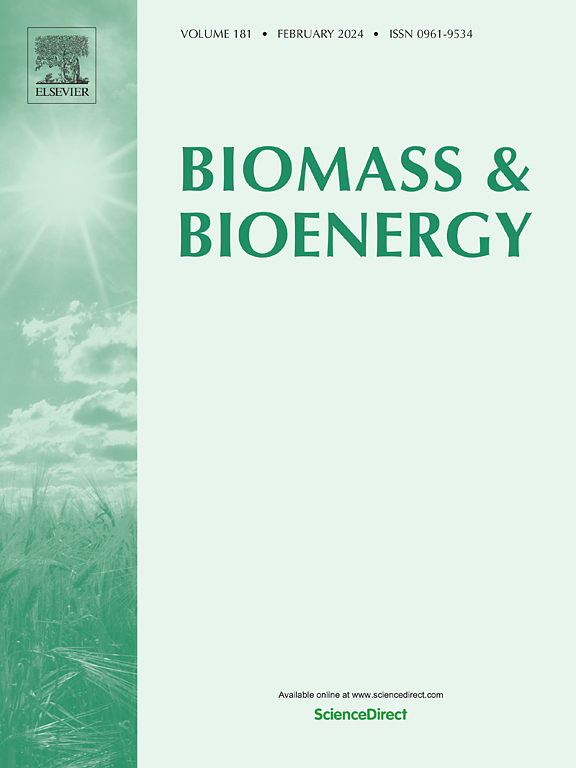高附加值产品生物经济的战略途径:拉脱维亚林业部门的经验教训
IF 5.8
2区 生物学
Q1 AGRICULTURAL ENGINEERING
引用次数: 0
摘要
气候变化、全球对粮食和饲料日益增长的需求以及生物多样性的丧失,都要求向可持续、创新和以知识为基础的生物经济转变。与此同时,实施符合可持续原则的利用该部门和相关生物资源的战略方法也是一项重大挑战。因此,本研究旨在为政策和决策者制定一种方法,以促进以知识为基础的生物经济政策规划框架。为了绘制生物经济的发展机遇图,我们对拉脱维亚的林业部门进行了详细分析。这需要对该部门内的系统组成部分进行检查,其中包括收集和分析统计数据、报告以及森林部门利益相关者提供的官方信息,目的是全面了解拉脱维亚森林部门的概况。在确定该部门当前的促进因素和制约因素之后,选择了一些具有高附加值的利基产品,以促进该部门的发展。在小组模型建立过程中,专家们:(1)为拉脱维亚林业部门制定了 SWOT 矩阵;(2)选择了三种以木材为基础的高附加值产品--树木纺织品、刨花板、天然热包装;(3)详细阐述了 SWOT/TOWS 分析,以促进利基产品的战略制定。所开发的方法综合了 SWOT、TOWS 和 AHP 等成熟的科学方法,并采用了生物经济系统成分分析方法。因此,该方法不仅使林业部门分析过程系统化,而且还将分析结果应用于制定部门发展路径,旨在从低附加值生产转向高附加值生产。该方法的创新之处不仅在于所使用方法的组合,还在于所获得的洞察力,它允许从较窄的产品开发角度来理解该部门的促进因素和制约因素,反之亦然。本文章由计算机程序翻译,如有差异,请以英文原文为准。
Strategic pathways for a bioeconomy with high value-added products: Lessons learnt from the Latvian forest sector
Climate change, the increasing global demand for food and feed and the loss of biodiversity, requires a shift towards a sustainable, innovative and knowledge-based bioeconomy. Simultaneously, the implementation of a strategic approach to the utilization of the sector and associated bioresources that aligns with the principles of sustainability represents a significant challenge. The aim of this study is therefore to develop a methodology for policy and decision makers to facilitate a knowledge-based bioeconomy policy planning framework. To map the development opportunities of the bioeconomy, a detailed analysis was conducted on the Latvian forest sector. This entailed an examination of the system's components within the sector, which involved the collection and analysis of statistical data, reports, and official information from forest sector stakeholders, with the objective of obtaining a comprehensive overview of Latvia's forest sector. Following the identification of the current enablers and constraints of the sector, a selection of niche products with high value-added for sector development was made. During group model building experts: (1) developed a SWOT matrix for the Latvian forest sector; (2) selected three wood-based high value-added products – textile from trees; particle board; natural thermal packaging; (3) elaborated SWOT/TOWS analysis to facilitate strategy development for the niche products. The developed methodology incorporates a synthesis of established scientific methods, including SWOT, TOWS, and AHP, with a bioeconomy system component analysis approach. The methodology therefore not only systematises the process of forest sector analysis, but also applies the findings to the development of sector development pathways aimed at shifting from low value-added to high value-added production. The innovation of the methodology lies not only in the combination of methods used, but also in the insights gained, which allow for a narrower product development perspective to be taken in order to understand the enablers and constraints of the sector and vice versa.
求助全文
通过发布文献求助,成功后即可免费获取论文全文。
去求助
来源期刊

Biomass & Bioenergy
工程技术-能源与燃料
CiteScore
11.50
自引率
3.30%
发文量
258
审稿时长
60 days
期刊介绍:
Biomass & Bioenergy is an international journal publishing original research papers and short communications, review articles and case studies on biological resources, chemical and biological processes, and biomass products for new renewable sources of energy and materials.
The scope of the journal extends to the environmental, management and economic aspects of biomass and bioenergy.
Key areas covered by the journal:
• Biomass: sources, energy crop production processes, genetic improvements, composition. Please note that research on these biomass subjects must be linked directly to bioenergy generation.
• Biological Residues: residues/rests from agricultural production, forestry and plantations (palm, sugar etc), processing industries, and municipal sources (MSW). Papers on the use of biomass residues through innovative processes/technological novelty and/or consideration of feedstock/system sustainability (or unsustainability) are welcomed. However waste treatment processes and pollution control or mitigation which are only tangentially related to bioenergy are not in the scope of the journal, as they are more suited to publications in the environmental arena. Papers that describe conventional waste streams (ie well described in existing literature) that do not empirically address ''new'' added value from the process are not suitable for submission to the journal.
• Bioenergy Processes: fermentations, thermochemical conversions, liquid and gaseous fuels, and petrochemical substitutes
• Bioenergy Utilization: direct combustion, gasification, electricity production, chemical processes, and by-product remediation
• Biomass and the Environment: carbon cycle, the net energy efficiency of bioenergy systems, assessment of sustainability, and biodiversity issues.
 求助内容:
求助内容: 应助结果提醒方式:
应助结果提醒方式:


